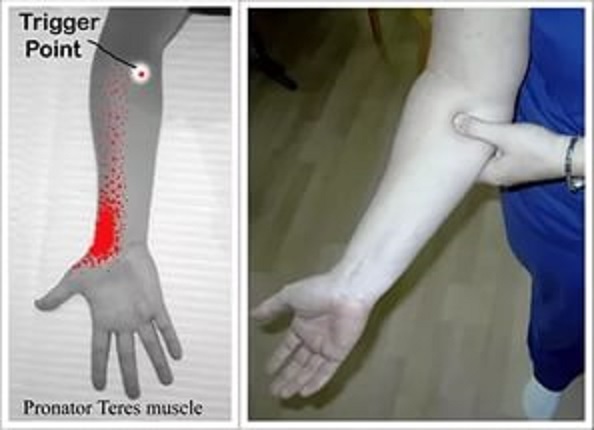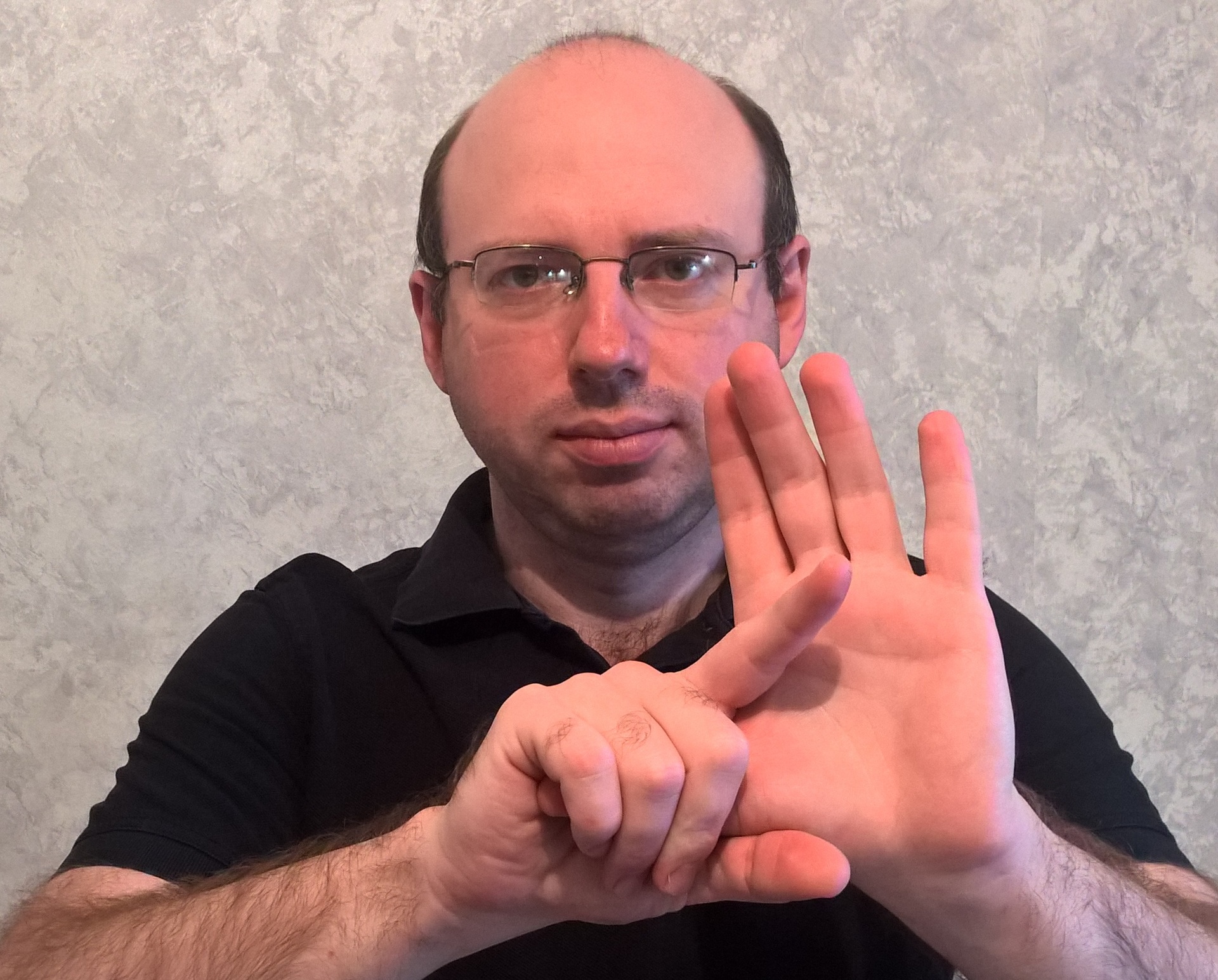Pain in the hands when working at the computer. Part 4: Integrating past lessons with a round pronator
In the previous articles of the cycle, you became acquainted with the diagnostics of the main tunnel syndromes of the upper limb , learned to relieve tension from the shoulder girdle, and relieved tension from the scalene muscles.
These were the preparatory moments for a functional lesson - by making a lesson from this article, you will learn to move your arms so that strong movements make strong muscles of the shoulder girdle, and small and precise ones make weaker, but accurate muscles of the forearm. A side effect of this lesson is the removal of tension from a round pronator, a muscle that turns the forearm inward.

Most often, the round pronator is overstrained with twisting movements of the arm (working with a screwdriver), however, even when working at a computer, this place can be injured by a sharp edge or a lining on the edge of the table.
')
Test for the presence of a problem: strongly push in the trigger point of a round pronator with a thumb - the appearance of unpleasant sensations along the median nerve is an indicator of the possible presence of a round pronator syndrome.
I remind you that you are doing a lesson, not an exercise. Combine reading instructions with their implementation. The task of the lesson is not to make the movement according to the instructions, but to consciously test various motor moments in order to find the most comfortable and high-quality way of making the movement exactly in your situation.
Qualitative movement involves normal muscle tone. Normalization of muscle tone, key to the occurrence of tunnel syndrome, leads to a rapid decrease in symptoms.
A lesson for the integration of movements of the shoulder girdle and forearms
Test the stress of the shoulder girdle, make a load test on the scalene muscles (there are links at the beginning of the article where these tests are described), check the trigger point of the circular pronator.
Sit in the middle of the chair. Focus on what happens in the body. Remember that movements are performed slowly, smoothly, in a state of comfort.
Comfort is important so that nothing distracts from the study of the motor situation. The maximum amount of movement, excessive diligence, making movements through pain, with great effort - all these are signs of getting out of the comfort zone.
It is impossible to correct what you do not notice. Consciousness responds to the situation very slowly - 3-4 times slower than automatisms, which control habitual movements and usual posture, do it, therefore only very slow and smooth movement can be consciously analyzed. The return of conscious control over motor automatisms is an important prerequisite for the formation of a new quality of movement and the normalization of muscle tone.
If your thoughts go for a walk in the past or future during the lesson, the result will be weak. Your body exists in the present, and only in the present can you learn to control it qualitatively. Attention to the processes occurring during the movement, allows you to rework the usual patterns of movements and postures.
Expose the open palm away, sticking the thumb of the hand to the side. Clasp his other hand into a fist. On the hand, clenched in a fist, set the index finger.

Now, clasp the index finger of the second hand into a fist with your fingers first. It turns out two fists, interconnected - in one fist there is a thumb, in the second - the index finger of the other hand.

Situation 1:
Place your hands, knitted with each other, on the table or thighs. And gently, smoothly, in a small volume start rolling them to yourself and from yourself. Notice that as the amount of movement increases, not only the forearms and fists, but also the shoulder joints become involved.
At that moment, when the hands roll away from themselves, the shoulder blades and shoulder girdle rise slightly to the ceiling and move slightly forward. When rolling the arms backwards, the shoulder girdles are lowered, tension is removed from them. Allow yourself to completely remove the tension from the muscles that participated in the movement before the start of a new one.
Do this movement several times, spread your arms and rest. Check what has changed - now how do you feel the length of the arms, is there any heaviness or lightness in the body, how do the pain points in the body behave (if you have found them before), what is the height of standing shoulders compared to the original, before the lesson .
Situation 2:
Change the grip of the hands in the original position on the mirror. Try to do the same hand rolls as in the first situation, but this time make minimal movements for the maximum possible time, try to make movements from the shoulder girdle, including the shoulder blades and shoulder girdle, without engaging the forearm muscles.
Make a move a few times and rest. Notice what has changed in your emotional state, did you want to sleep? You can test yourself again for symptoms for tunnel syndromes.
This lesson is effective for relieving tension in the upper arms and arms up to the hand. Periodically performing this simple movement in training mode, you can learn to reduce slouching and fall asleep more easily after a hard day at work.
In the comments I would like to see your feedback on what happened during your lesson, your feelings during the lesson and the results.
These were the preparatory moments for a functional lesson - by making a lesson from this article, you will learn to move your arms so that strong movements make strong muscles of the shoulder girdle, and small and precise ones make weaker, but accurate muscles of the forearm. A side effect of this lesson is the removal of tension from a round pronator, a muscle that turns the forearm inward.

Most often, the round pronator is overstrained with twisting movements of the arm (working with a screwdriver), however, even when working at a computer, this place can be injured by a sharp edge or a lining on the edge of the table.
')
Test for the presence of a problem: strongly push in the trigger point of a round pronator with a thumb - the appearance of unpleasant sensations along the median nerve is an indicator of the possible presence of a round pronator syndrome.
I remind you that you are doing a lesson, not an exercise. Combine reading instructions with their implementation. The task of the lesson is not to make the movement according to the instructions, but to consciously test various motor moments in order to find the most comfortable and high-quality way of making the movement exactly in your situation.
Qualitative movement involves normal muscle tone. Normalization of muscle tone, key to the occurrence of tunnel syndrome, leads to a rapid decrease in symptoms.
A lesson for the integration of movements of the shoulder girdle and forearms
Test the stress of the shoulder girdle, make a load test on the scalene muscles (there are links at the beginning of the article where these tests are described), check the trigger point of the circular pronator.
Sit in the middle of the chair. Focus on what happens in the body. Remember that movements are performed slowly, smoothly, in a state of comfort.
Comfort is important so that nothing distracts from the study of the motor situation. The maximum amount of movement, excessive diligence, making movements through pain, with great effort - all these are signs of getting out of the comfort zone.
It is impossible to correct what you do not notice. Consciousness responds to the situation very slowly - 3-4 times slower than automatisms, which control habitual movements and usual posture, do it, therefore only very slow and smooth movement can be consciously analyzed. The return of conscious control over motor automatisms is an important prerequisite for the formation of a new quality of movement and the normalization of muscle tone.
If your thoughts go for a walk in the past or future during the lesson, the result will be weak. Your body exists in the present, and only in the present can you learn to control it qualitatively. Attention to the processes occurring during the movement, allows you to rework the usual patterns of movements and postures.
Expose the open palm away, sticking the thumb of the hand to the side. Clasp his other hand into a fist. On the hand, clenched in a fist, set the index finger.

Now, clasp the index finger of the second hand into a fist with your fingers first. It turns out two fists, interconnected - in one fist there is a thumb, in the second - the index finger of the other hand.

Situation 1:
Place your hands, knitted with each other, on the table or thighs. And gently, smoothly, in a small volume start rolling them to yourself and from yourself. Notice that as the amount of movement increases, not only the forearms and fists, but also the shoulder joints become involved.
At that moment, when the hands roll away from themselves, the shoulder blades and shoulder girdle rise slightly to the ceiling and move slightly forward. When rolling the arms backwards, the shoulder girdles are lowered, tension is removed from them. Allow yourself to completely remove the tension from the muscles that participated in the movement before the start of a new one.
Do this movement several times, spread your arms and rest. Check what has changed - now how do you feel the length of the arms, is there any heaviness or lightness in the body, how do the pain points in the body behave (if you have found them before), what is the height of standing shoulders compared to the original, before the lesson .
Situation 2:
Change the grip of the hands in the original position on the mirror. Try to do the same hand rolls as in the first situation, but this time make minimal movements for the maximum possible time, try to make movements from the shoulder girdle, including the shoulder blades and shoulder girdle, without engaging the forearm muscles.
Make a move a few times and rest. Notice what has changed in your emotional state, did you want to sleep? You can test yourself again for symptoms for tunnel syndromes.
This lesson is effective for relieving tension in the upper arms and arms up to the hand. Periodically performing this simple movement in training mode, you can learn to reduce slouching and fall asleep more easily after a hard day at work.
In the comments I would like to see your feedback on what happened during your lesson, your feelings during the lesson and the results.
Source: https://habr.com/ru/post/399697/
All Articles